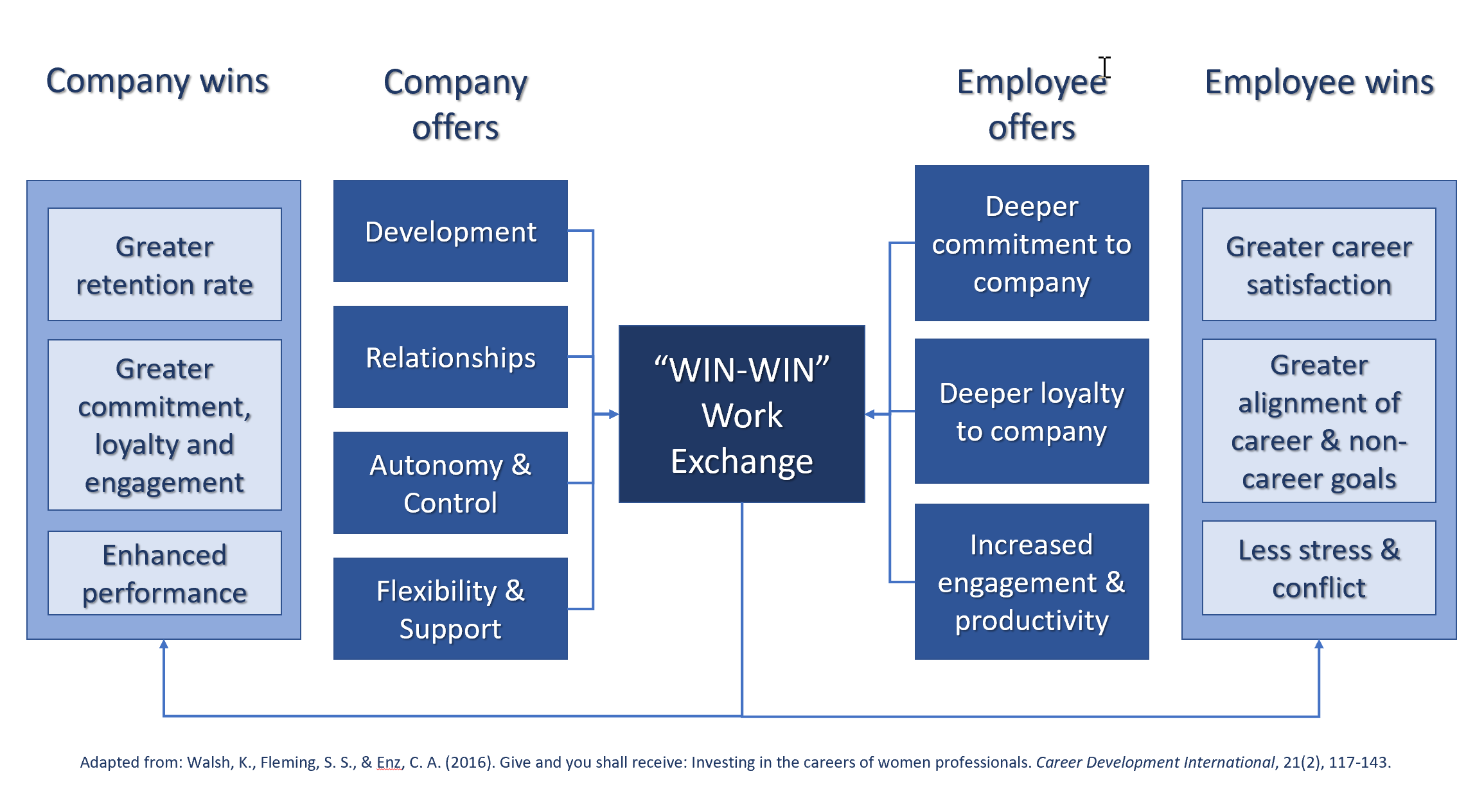Human capital is a company’s most important asset. Yet many companies lose a disproportionately high percentage of its capital over time: women professionals.
Even though women make up half or more of university degree programs, they comprise a much smaller percentage of executive or C-suite positions. They account for less than 30% of senior leadership globally and less than 7% of CEOs of Fortune 500 companies.
Why?
Many reasons have been given over the years, but they seem to boil down to one: stress. And I’m not just saying that because I am a stress researcher.

Photo by Kaspars Grinvalds from Canva Pro
Why are women more stressed out at work than men?
Research shows that women experience higher levels of stress and anxiety at work than men.
The reasons all seem related to stress in one way or another. Take, for instance, the fact that about 4 in every 10 highly qualified women voluntarily take a break from their careers at some point. When asked why, many women cite other priorities such as caring for children and/or elderly parents and addressing personal health concerns. This agrees with research reported in part 1 of this series that women, compelled by internal instincts or external forces or both, often carry more caregiver/domestic labor responsibilities than men.
Few of us would argue the importance of these personal priorities. But their importance also gives them heft. To manage the heavy load, other priorities – like career aspirations – must be either re-arranged or dropped completely.
And it’s not hard to predict the end result: a woman’s career is much more likely to look “non-traditional” or “non-linear” compared to a man’s (Moen and Han, 2001). Statistically speaking, it contains considerably more “off-ramps” and, further down life’s road, “on-ramps” back into jobs with poorer pay and less prestige.
There is also often a disconnect between the values traditionally lauded in the workplace – long hours, above-and-beyond effort, and single-minded focus – with a multi-focused meld of career and family values. This disconnect can create tension in the workplace, which often translates into higher levels of stress, anxiety, and poor health. Women working in male-dominated jobs take more sick leave and experience more health issues than women or even men in female-dominated jobs.

Photo by Robert Kneschke from Getty Images
What companies can do to reduce stress for women in the work environment
The following model is adapted from Cornell University researchers Kate Walsh, Susan Fleming, and Cathy Enz in their excellent article, Give and you shall receive: Organizational strategies for advancing women’s careers.

Illustration by Pamela Coburn-Litvak
At the center of the model is a fair exchange of “goods” between the organization and women employees. The left shows what the organization can offer (I’ve modified these a little to include some best practices from organizational research):
- Development
- Relationships
- Autonomy and Control
- Support

Photo by Minerva Studio from Getty Images
Professional development opportunities
Stress research has long shown that two things especially stress us out: unpredictability and lack of control. This holds true for careers as well.
For women to stay engaged at work, they need to see a clear career path ahead. And this path must be able to bend around the multi-faceted, more family-centric priorities a woman may bring to the workplace.
This is not to say that men are not also striving for better work-life balance – many are. But research shows that long-term career planning is particularly important for women, perhaps because their career paths are more easily derailed. Companies “need to be proactive and purposeful in identifying, developing, communicating and implementing a path for successful advancement” to their women workforce (Walsh, Fleming, and Enz, 2016).

Photo by Ana Stills from Canva Pro
Relationships (Role models, Mentors, Executive coaches)
Relationships are also key to managing stress. Providing women with social support in the form of role models, mentors, and coaches will reduce their workplace stress and increase their engagement.
In 2012, Sealy and Doherty interviewed 34 high level women working in six global investment banks. Specifically, they were asked to describe how female role models had enriched or supported their career.
They mentioned several things. First, role models provide relatability in the workplace. They may share similar backgrounds or hold similar values. As fellow mothers or caregivers, they have navigated the same work-life balance issues that face younger women. They also “[serve] as symbols of hope in providing tangible evidence that some women succeed, that women can retain their uniqueness and still be successful (Richardsen, Traavik, and Burke, 2016).”
Mentoring allows older, more experienced women to pass on guidance and support to younger women. Companies can facilitate this by hosting network events, providing mentorship training, including mentorship in performance metrics, and offering mentor-mentee pairing services.
Executive coaching has been shown to be very effective in helping women establish a sense of professional identity, “reducing the impact of male norms of leadership at senior levels, managing women’s motivation, and understanding how they could lead with authenticity (Madsen, 2017).” Sub-types of coaching such as “maternity coaching” may help women re-establish their career and professional identity after a family-related absence (Filsinger, 2012).

Autonomy and Control
As mentioned earlier, there are two parts to stress that can make it feel a lot more stressful: unpredictability and lack of control. Through the middle years of a woman’s career, any sense of control may well evaporate as she tries to take on greater work responsibilities while also juggling the demands of children, spouse, and aging parents.
The goal of companies should be to help their women employees get that sense of control back. When Cornell researchers interviewed 20 female executives about this, they recommended two specific initiatives.
First, allow women employees to have as much autonomy and control as possible, especially during their mid-career stages. “Whether it [is] offering flexibility, or simply conveying trust that the job would get done (e.g. whether or not the person was in the office from 9 am to 5 pm), these small efforts on the part of the organization [are] viewed as symbolic and substantive signals of appreciation and value (Walsh, Fleming, and Enz, 2016).”
Second, create an infrastructure of community and support for working professionals that may extend beyond the boundaries of the workplace. The female executives gave examples of companies helping employees find schools, doctors, parent networks, and other non-work resources that helped them stay on track and focused on work.
Such support should also include an “on-ramp” plan to help those who have had to temporarily leave their responsibilities to re-enter the workforce efficiently and effectively.

Photo by Pressmaster for Canva Pro
Flexibility and Support
At the risk of sounding repetitive, flexibility is key to reducing stress and increasing engagement for women employees.
Numerous flexible work arrangements have been shown to help with work-life balance: reduced work arrangements, job sharing, teleworking or telecommuting, compressed work week, flexible work hours, and parental leave policies (Madsen, 2017).
Companies are much more likely to retain their female employees if they actively reduce the stigma of nontraditional work arrangements. They can do this by promoting a culture of healthy work-life balance for both men and women employees and maintaining relationships with those on family/personal leave.
For women, a culture of acceptance in huge. In one study of over 140 women professionals and managers, four work experience were positively linked to greater work satisfaction and psychological well-being: 1) support and encouragement, 2) feeling accepted in the company, 3) opportunities for training and development, and 4) promoting healthy work-life balance (Burke et al, 2012).
Conclusion
Too often, companies and their women employees feel they must work at cross purposes to achieve their goals. Companies want to protect their investment in human capital, while women professionals are trying to serve their employer’s needs while not compromising the quality and integrity of nonwork-related priorities and values. The tension created in the process can be substantial. When it reaches the breaking point, the women employees often walk away to the detriment of both sides.
Both sets of goals can be served in the above “exchange” model. When companies look out for their employees, serving both their short- and long-term career needs, the employees will give something in return: greater commitment and productivity.
A win-win.

